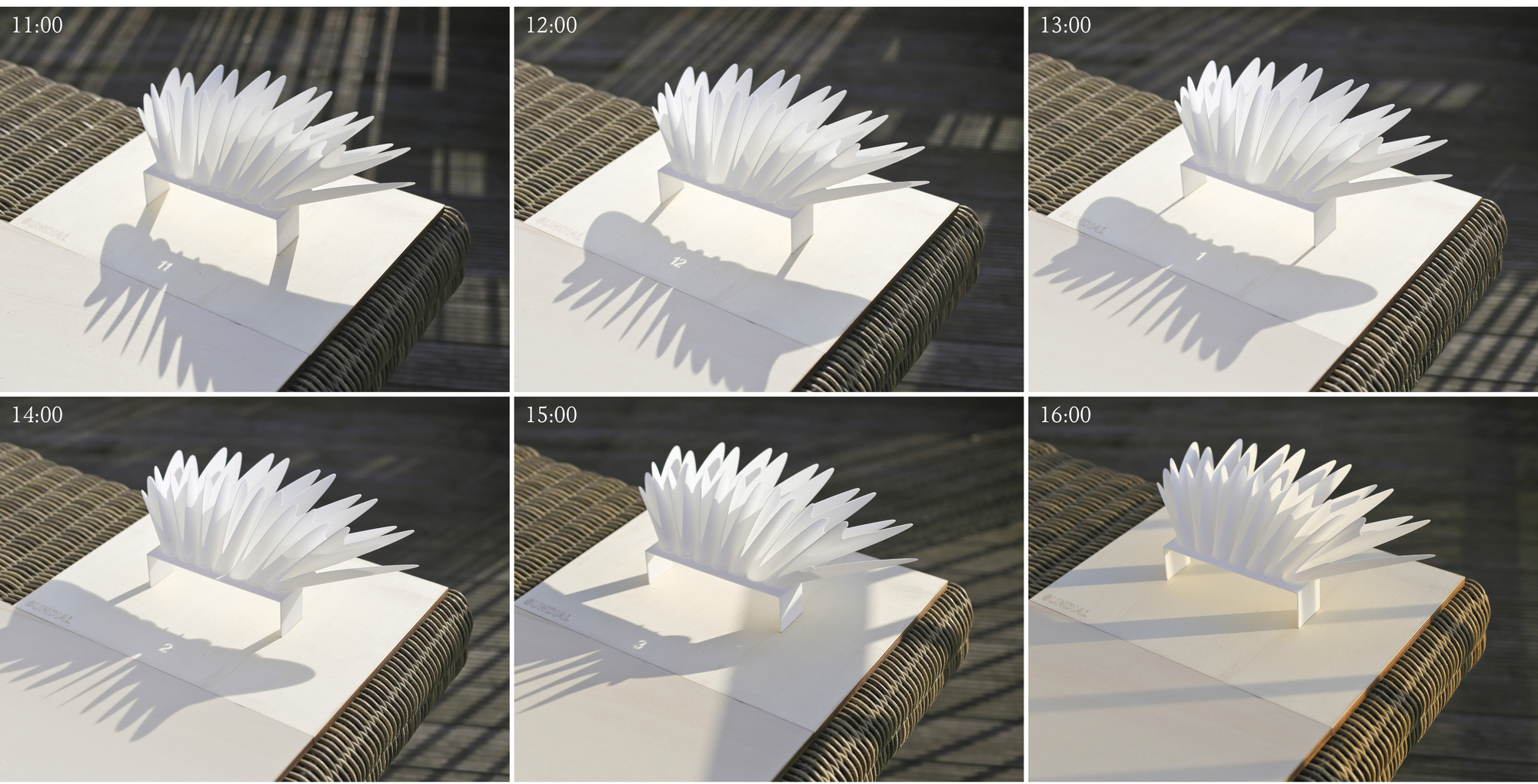- Details
- Hits: 12425
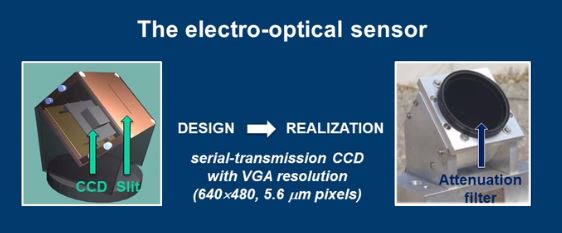 The National Agency for New Technologies, Energy and Sustainable Economic Development (ENEA) is an Italian Government sponsored research and development agency. In 2017 Sara Bollanti and her team at ENEA in Frascati developed a solar compass that "is 100 times more precise than magnetic compasses..." with applications for surveying, civil engineering, and for us, sundial alignment. The heart of the device is a combination of GPS receiver for determining both time and geographic position and a solar collector consisting of a narrow slit and a CMOS image detector. Essentially this is an electronic solar azimuth compass. A smallArduino computer uses the UTC time plus geographic coordinates to compute the local sun azimuth and then compares it to the position of the sun's projection of a slit on a CMOS detector. According to ENEA, the "...electronic solar compass is compact, completely automatic, cheap, and reaches an accuracy better than 1 arcmin. The latter is one of the best currently available values, comparable to those achievable by means of much more expensive and sophisticated devices, like coupled GPS systems (see for example U.S. patent 5,617,317A, 1997) or gyrocompasses. Furthermore, the ENEA compass provides the orientation in a few seconds, a time extremely shorter than that necessary for gyrocompasses."
The National Agency for New Technologies, Energy and Sustainable Economic Development (ENEA) is an Italian Government sponsored research and development agency. In 2017 Sara Bollanti and her team at ENEA in Frascati developed a solar compass that "is 100 times more precise than magnetic compasses..." with applications for surveying, civil engineering, and for us, sundial alignment. The heart of the device is a combination of GPS receiver for determining both time and geographic position and a solar collector consisting of a narrow slit and a CMOS image detector. Essentially this is an electronic solar azimuth compass. A smallArduino computer uses the UTC time plus geographic coordinates to compute the local sun azimuth and then compares it to the position of the sun's projection of a slit on a CMOS detector. According to ENEA, the "...electronic solar compass is compact, completely automatic, cheap, and reaches an accuracy better than 1 arcmin. The latter is one of the best currently available values, comparable to those achievable by means of much more expensive and sophisticated devices, like coupled GPS systems (see for example U.S. patent 5,617,317A, 1997) or gyrocompasses. Furthermore, the ENEA compass provides the orientation in a few seconds, a time extremely shorter than that necessary for gyrocompasses."
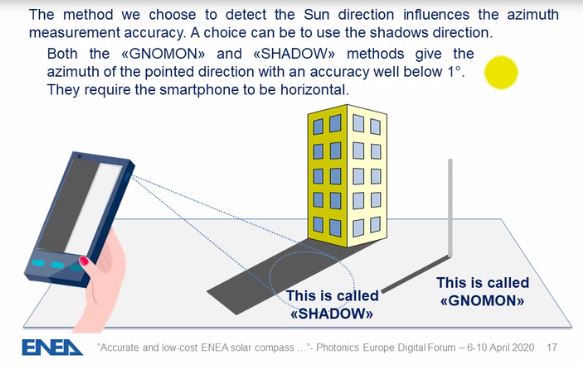 By 2018 this was tested in Antarctica and now the mathematics has been reduced to fit into your smart phone. In April 2020 the ENEA team announced the developed the smartphone app i called "SunPass". It is currently in beta testing and will soon be available at the Play Store. In basic form, the app allows you to acquire the sun azimuth by pointing toward the shadow of a vertical object such as a building ("shadow method") or the shadow of a vertical pole ("gnomon method"). A more accurate appraoch is to construct a box with a slit on the front and hole on top such that the smartphone can observe the illuminated sun line on the floor of the box ("Slit method"). For the advanced, one can construct a precision holder from a kit that mounts on a tripod.
By 2018 this was tested in Antarctica and now the mathematics has been reduced to fit into your smart phone. In April 2020 the ENEA team announced the developed the smartphone app i called "SunPass". It is currently in beta testing and will soon be available at the Play Store. In basic form, the app allows you to acquire the sun azimuth by pointing toward the shadow of a vertical object such as a building ("shadow method") or the shadow of a vertical pole ("gnomon method"). A more accurate appraoch is to construct a box with a slit on the front and hole on top such that the smartphone can observe the illuminated sun line on the floor of the box ("Slit method"). For the advanced, one can construct a precision holder from a kit that mounts on a tripod.
ENEA's goal of a low cost, simple method of precision alignment is now accessible to all. This new technology implements the mathematics of determining the sun's azimuth in elegant ways. But of course it only works on sunny days.
Read more at:
http://eai.enea.it/archivio/anno-2017/astana-italy/the-enea-solar-compass-how-to-catch-more-sun-by-using-the-sun
And watch the video:
https://www.spiedigitallibrary.org/conference-proceedings-of-spie/11352/1135216/Accurate-and-low-cost-ENEA-solar-compass-for-precision-metrology/10.1117/12.2555747.full?SSO=1
- Details
- Hits: 12936
Whether it be Delhi or Las Vegas, artist Daku brings shadows to life, creating words that slowing change their shape but never lose their meaning through the course of the day. As reported by mymodernmet.com, "As part of the St.Art festival, which curates public art in Delhi’s Lodhi district, Daku’s carefully realized [shadow] installation demonstrates the power of words. The artist, whose name means 'bandit' in Hindi, had been thinking about executing this project for several years when finally given the opportunity by the festival." The anonymous artist Daku told CNN, “I had to decide the size of the letters, the length of the pieces, and the angle I could place them in so pedestrians could easily see it.” mymodernmet.com concluded "The artist carefully selected which words to include—balance, order, reflection, future, seasons, space—each a reflection on movement, time, and change. Reaching its apex at mid-day, the letters slowly blur and dissolve, put to rest each evening before beginning anew."
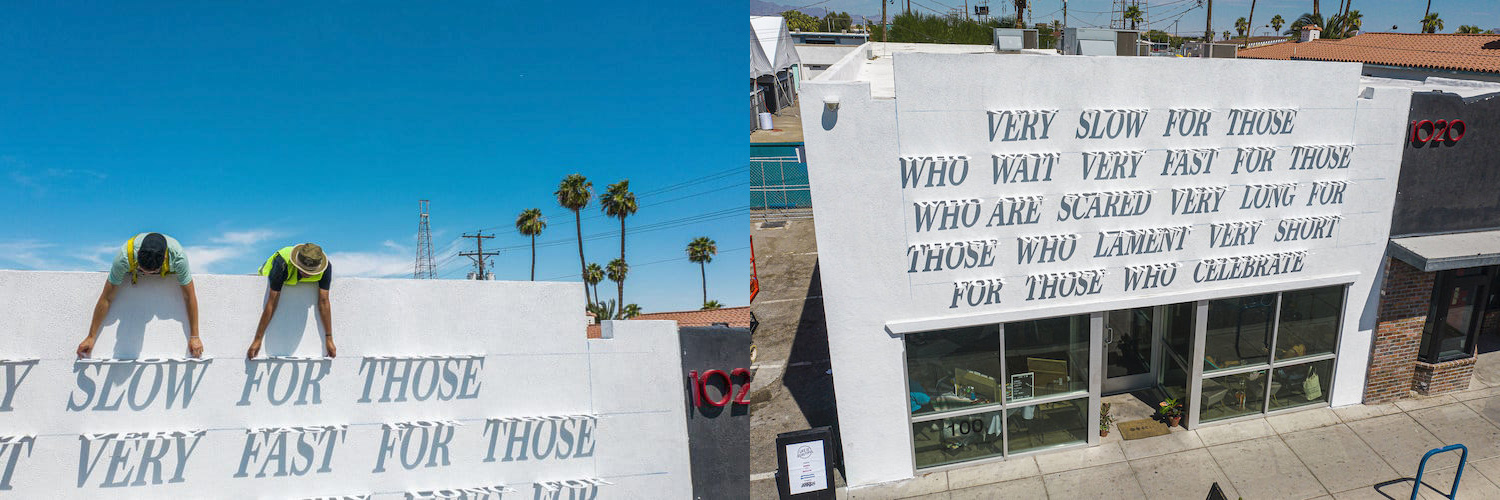
The making of shadow writing in Las Vegas by Daku
Daku's cut-out words on the south facing walls of buildings is a clever implementation of sundial and involves a lot of subtle mathematics. Daku's lettering is placed on the wall horizontal to the ground, usually with very little change in the scale of the lettering. Mathematically the noonday lettering on the wall is lengthened by the tangent of the latitude plus solar declination. But the visible size of the lettering is foreshortened by the cosine of the upward look angle of the pedestrian on the ground.
Read more at: Daku's installation in Las Vegas and Daku's installation in Delhi
- Details
- Hits: 17603
As reported in the ArchDaily.com website on 23April 2016 by Patric Lynch, the design group Prescription in conjunction with Arup have developed a sophisticated sundial based on the analemmic path that the sun travels throughout the year. The classic "8" shaped analemma is made into a cone (think of someone stepping on an ice cream cone) and repeated with esthetic cutting of the cone top for each hour. At the bottom of the cone is a stenciled hour number and the angle of the analemmic cone only allows sunlight to poke through the stencil for the appointed hour.
The original prototype of this dial was made of flexible plastic through a 3D printing process. Prescription believes that "...the design is 100% scalable; the designers foresee applications for the design in both park and festival pavilions and home installations..."
A video of this analemmic sundial by Grisha Zotov can be seen at https://vimeo.com/161675472
- Details
- Hits: 24203
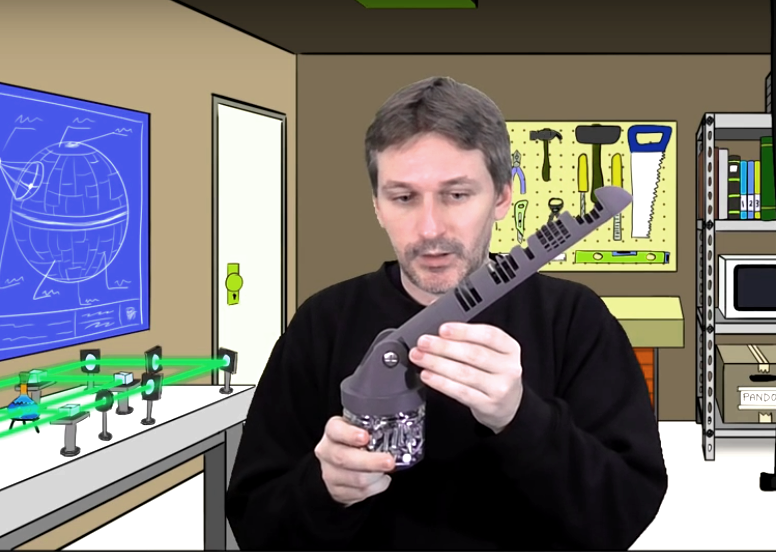 French inventor and maker of things Julien Coyne of Mojoptix has created an intriguing digital sundial gnomon that can be 3D printed. His software design (dated 13 October 2015) uses the 3D open software OpenSCAD described as "The Programmers Solid 3D Computer Aided Design Modeller".[http://www.openscad.org/about.html].
French inventor and maker of things Julien Coyne of Mojoptix has created an intriguing digital sundial gnomon that can be 3D printed. His software design (dated 13 October 2015) uses the 3D open software OpenSCAD described as "The Programmers Solid 3D Computer Aided Design Modeller".[http://www.openscad.org/about.html].
In a Mojoptix video [http://www.mojoptix.com/fr/2015/10/12/ep-001-cadran-solaire-numerique] (available in both French and English) the inventor describes how the digital gnomon shows digital time by making virtual "light tunnels" that burrow through a half-cylinder 3D software object. He accurately describes how a sundial works good (except of course for placing a penguin at the north pole) and how the "tiny tunnels" generate "a complicated Swiss Cheese" of holes and grooves that result in a gnomon that casts sunlight in a dotted pattern of numbers that change promptly every 20 minutes running from 10am (10:00) to 4pm (16:00).
The sundial is adjustable for any latitude and rotates slightly to accommodate daylight savings time, site longitude, or the date's equation of time (though no markings are made so making these angles are guesswork). His free, open software script allows 3D printing for either the Northern or Southern hemisphere.
For those who do not have a 3D printer, he makes the digital dial available from his on-line store for $54 USD plus shipping. Even with a fast 3D printer, the dial takes about 35 hours of printer time. This digital gnomon is a wonderful addition to both the world of dialing and 3D printing. The only down-side is that the dotted numerals have light tunnels placed too close together, resulting in an entrance angle of only +/- 15 deg. Since the sun annually moves +/- 23.5 deg in declination, this digital gnomon sadly won't work when the sun heads toward the summer solstice from about 1 May to 10 Aug and likewise blanks out in the winter from about 5 Nov to 5 Feb.
- Details
- Hits: 13439
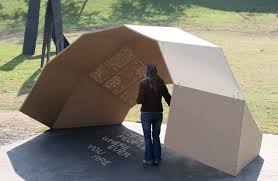 Jiyeon Song is a very talented media designer who created the One Day Poem Pavilion where here messages flow slowly by on the ground because they follow the movement of the sun. Jiyeon reflects “these slow messages offer the audience time to meditate. We cannot force it to go fast. We should wait. We live under the laws of nature. Slowness affords us time to rethink our lives which are finite and valuable. While the poem is revealed slowly, the meaning will resonate with the audience.”
Jiyeon Song is a very talented media designer who created the One Day Poem Pavilion where here messages flow slowly by on the ground because they follow the movement of the sun. Jiyeon reflects “these slow messages offer the audience time to meditate. We cannot force it to go fast. We should wait. We live under the laws of nature. Slowness affords us time to rethink our lives which are finite and valuable. While the poem is revealed slowly, the meaning will resonate with the audience.”
- Details
- Hits: 17402
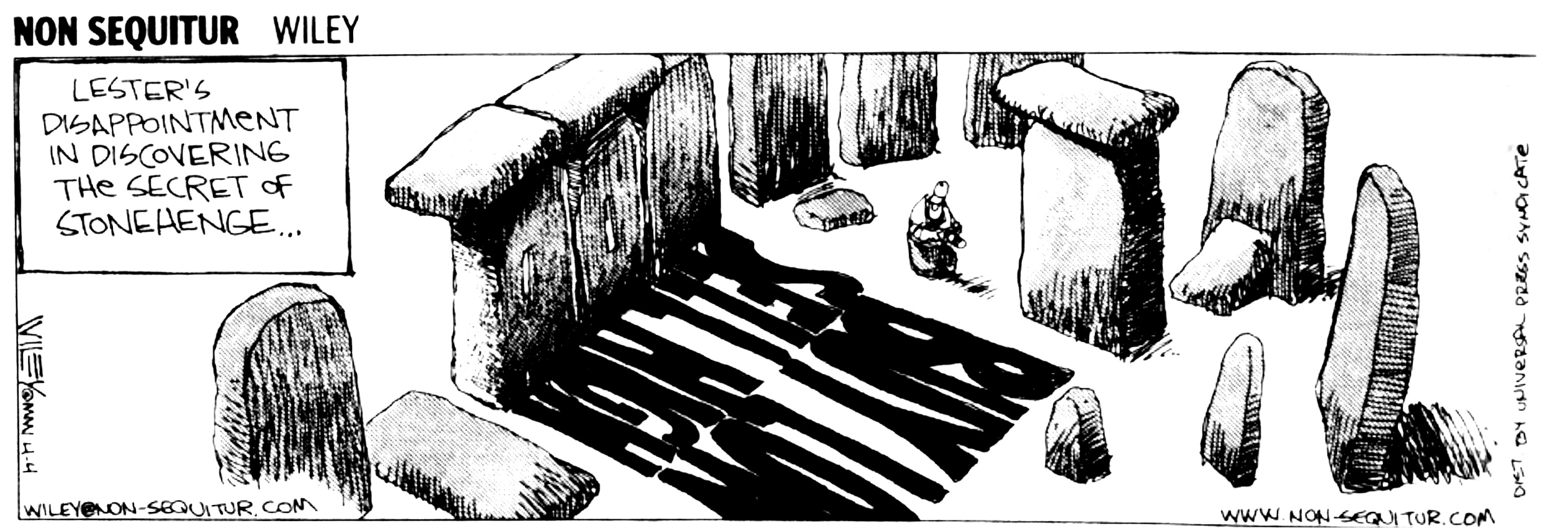
Digital sundials have captured the imagination of many people, including cartoonists such as Wiley’s secret of Stonehenge shown below, which correctly displays the shadow bounds of the vertical stone gnomon. Two sundial enthusiasts who took Stewart’s article seriously were Robert Kellogg and Daniel Scharstein. Working independently, they both created and patented digital sundials that emulate Brother Benjamin’s mythic fractal sundial. Kellogg and Scharstein received nearly simultaneous patents, separated by only three weeks.
- Details
- Hits: 16051
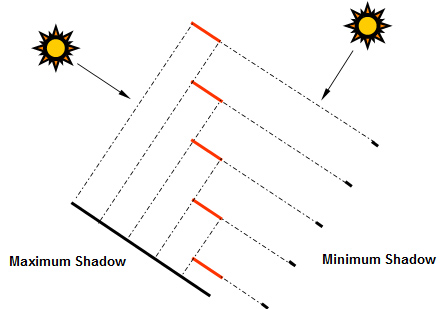 In the late 1980’s and early 1990’s several interesting articles appeared in mathematical journals discussing the possibility of fractal and digital sundials. The works of Manfred Schroeder [1] and K.J. Falconer [2] describe Cantor-like fractals embedded in a higher dimension.
In the late 1980’s and early 1990’s several interesting articles appeared in mathematical journals discussing the possibility of fractal and digital sundials. The works of Manfred Schroeder [1] and K.J. Falconer [2] describe Cantor-like fractals embedded in a higher dimension.
Schroeder, in his article on “Fractals, Chaos, Power Laws” (1991) described a set of Venetian blinds: “[The ] idea underlying digital sundial is a set of bars that casts very different shadows depending on the direction of projection.”
Ultimately both Schroeder and Falconer imagined a multi-dimensional object, that when projected along one axis, casts a shadow, but when projected along another axis, shows only light with a “weightless” shadow. Although the mathematical principle is correct, the implementation is vague. As Schroeder stated, “...of course, the shadow-casting set is likely to be rather complicated, and the inventor understandably refrains from detailed instructions for its construction…”
- Details
- Hits: 24873
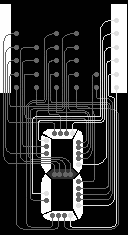 Hines Digital Dial with light moving across optical fibers to create numbers
|
Steve Hines developed the first true digital sundial in 1984 routing illuminated optical fibers in a cylinder to 7-segment numbers display hours and minutes. Ultimately he received US Patent 4,782,472 on November 1, 1988 for a “Solar Clock with Digital Time Display”. Steve is an inventor of many optical devices, but as he recalls, “Sundials had not been a strong interest of mine before I started this project. I knew that there were analog sundials on horizontal and vertical surfaces, with the gnomon having to be parallel to the earth’s rotational axis. However, I wondered if it would be possible to create a true digital sundial with a display made up of 7-segment numbers like on a clock radio. By defining the problem as an optical analog-to-digital converter made it all the more interesting, suggesting further uses beyond being a clock.”
Blueprints for his dial construction are now available at: https://www.hineslab.com/digital-sundial/
Steve Hines continues,“This concept was just quirky enough to rivet my attention. I was hooked. The expectation that it would not be commercial did not deter me at all, and it has wildly exceeded those expectations. The fascination for me was finding the optical and geometrical solution of converting the slowly-moving sun into blinking segments of light to form human-readable numbers.”
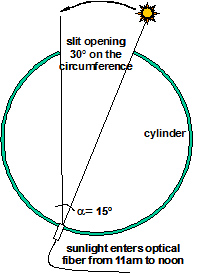 “I thought early on that I had nailed the solution based on sunlight shining through slits of a half cylinder shining onto optical fibers glued to a vector board. When tested in the middle of the day a “hour” seemed to display correctly for an hour of time. The problem of this approach was that an “hour” on the dial did not last an hour of time in the early morning or late afternoon. [Thew, who erarlier invented an analog sundial casting numbers from a half-cylinder band had to change the width of his numbers to account for this effect.] The breakthrough came by mounting the optical fibers on the back, and the entrance slits on the front of the same full cylinder.”
“I thought early on that I had nailed the solution based on sunlight shining through slits of a half cylinder shining onto optical fibers glued to a vector board. When tested in the middle of the day a “hour” seemed to display correctly for an hour of time. The problem of this approach was that an “hour” on the dial did not last an hour of time in the early morning or late afternoon. [Thew, who erarlier invented an analog sundial casting numbers from a half-cylinder band had to change the width of his numbers to account for this effect.] The breakthrough came by mounting the optical fibers on the back, and the entrance slits on the front of the same full cylinder.”
By using a cylinder, Steve Hines exploited the property of constant angular view from an opening anywhere inside the cylinder as shown in the figure at right This allowed Steve to define hour and minute slits to shine light onto a particular optical fiber at exactly the right time and for the right duration. Thus his wish to develop an optical analog-to-digital converter was practical. Steve Hines patent notes show a schematic of how at each hour portions of a 7-segment number are illuminated. In these notes he observes that “the angular subtense of the sun's diameter is about ½o, equivalent to motion for +/- 2 minutes. Therefore, the maximum temporal resolution for any clock is 4 minutes.” He chose time divisions of 10 minutes, a time mark followed later by other digital sundials.
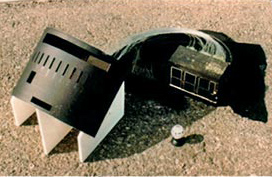 At left is Steve's first prototype of the digital sundial (Sept 14, 1984), confirming that slits on a cylinder accurately illuminate optical fibers that route sunlight to a 7-segment number display.
At left is Steve's first prototype of the digital sundial (Sept 14, 1984), confirming that slits on a cylinder accurately illuminate optical fibers that route sunlight to a 7-segment number display.
The detail of assembling a more refined version of the digital dial is shown below. Each number segment of Plexiglass has several optical fibers attached. The segments are assembled into a display box and the optical fibers are run to various illuminated spots on the cylinder. These spots will be illuminated at the correct time by slit openings on the opposite side of the cylinder. In the bottom row of photos you can see Hines assembled digital sundial and display at the north end. Why at the north end? It prevents the user's shadow from getting in the way of the cylinder and prevents the direct sun from shining onto the display. The optical fibers could have been any reasonable length and routed to the display at a convenient location, even indoors for a remote reading sundial. The display's black color increases the contrast.
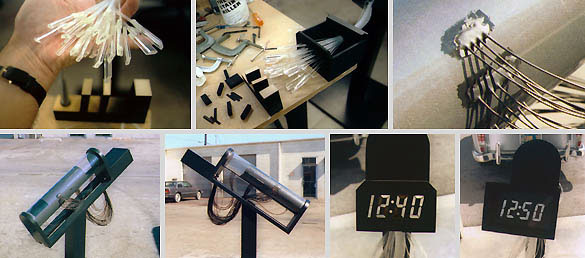
For more pictures of this digital dial, plans and many other wonderful patents by Steve Hines, visit www.HinesLab.com
Steve creates slits openings that are longitudinally straight. This provides sunlight illumination of the optical fibers according to local solar time. In theory the digital clock could give accurate clock time (civil time) by using a set of analemma shaped curves for the slit opening. The figure below shows Hines original cylinder mask at far left. In the middle are two analemma masks created by Robert Kellogg (another digital sundial inventor) to be used from June-December and December to June, and at far right, the analemma figure for a pinhole casting light onto the ground each day at solar mean noon.
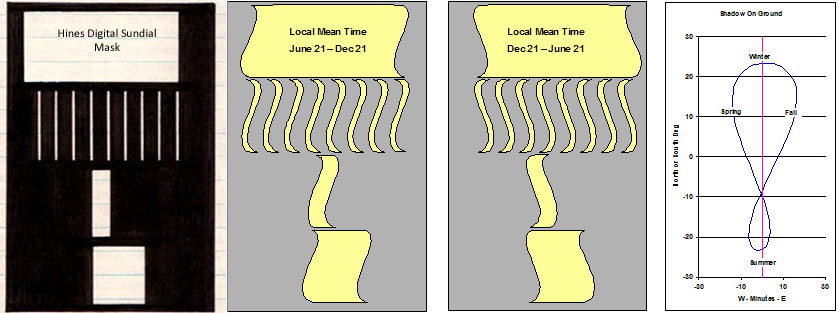
This proposed analemma scheme will not work in practice as it requires two complete masks (or two sundials) and will only work if all of the optical fibers assigned to a particular time interval are clustered into a point positioned half way between the slit ends. Steve Hines comments, "About the analemma and curved slits… I had thought of the concept of clustering all the fibers into a “point” to be able to use the analemma." But in the real world, he continues,"I felt I needed fibers large enough to get a bright display..." which clustered together would not make the ideal "point". As for periodically changing the dial mask sets, Hines wisely states "My preference in getting the most from a sundial is to have it as maintenance free as possible."
There is an interesting theoretical restriction to Hines’ cylindrical dial and other dials that use refractive mediums. Physically, light cannot enter a fiber optic at angles much beyond its the “numerical aperture”, representing Snell’s law of refraction of light going from air to a refractive medium. For example, if a glass fiber has an index of refraction of 1.65, then the maximum off-axis ray is 37.3o, or a little more than 2 hours time for the cylindrical geometry. This only allowing a total of 4 hours operation. Steve Hines recognized this theoretical limitation early in the sundial design and roughed up the ends of the optical fibers with fine sandpaper to allow light from greater angles to enter the fiber and p[ointed them toward the optimal slit alignment. Nothing succeeds more than practical insight. This is what makes Steve such an outstanding inventor.
In his words, "My overriding goal was to create an optical analog-to-digital converter, which I feel like I did." Below are Steve's original notes for explaining his invention of the first digital sundial.
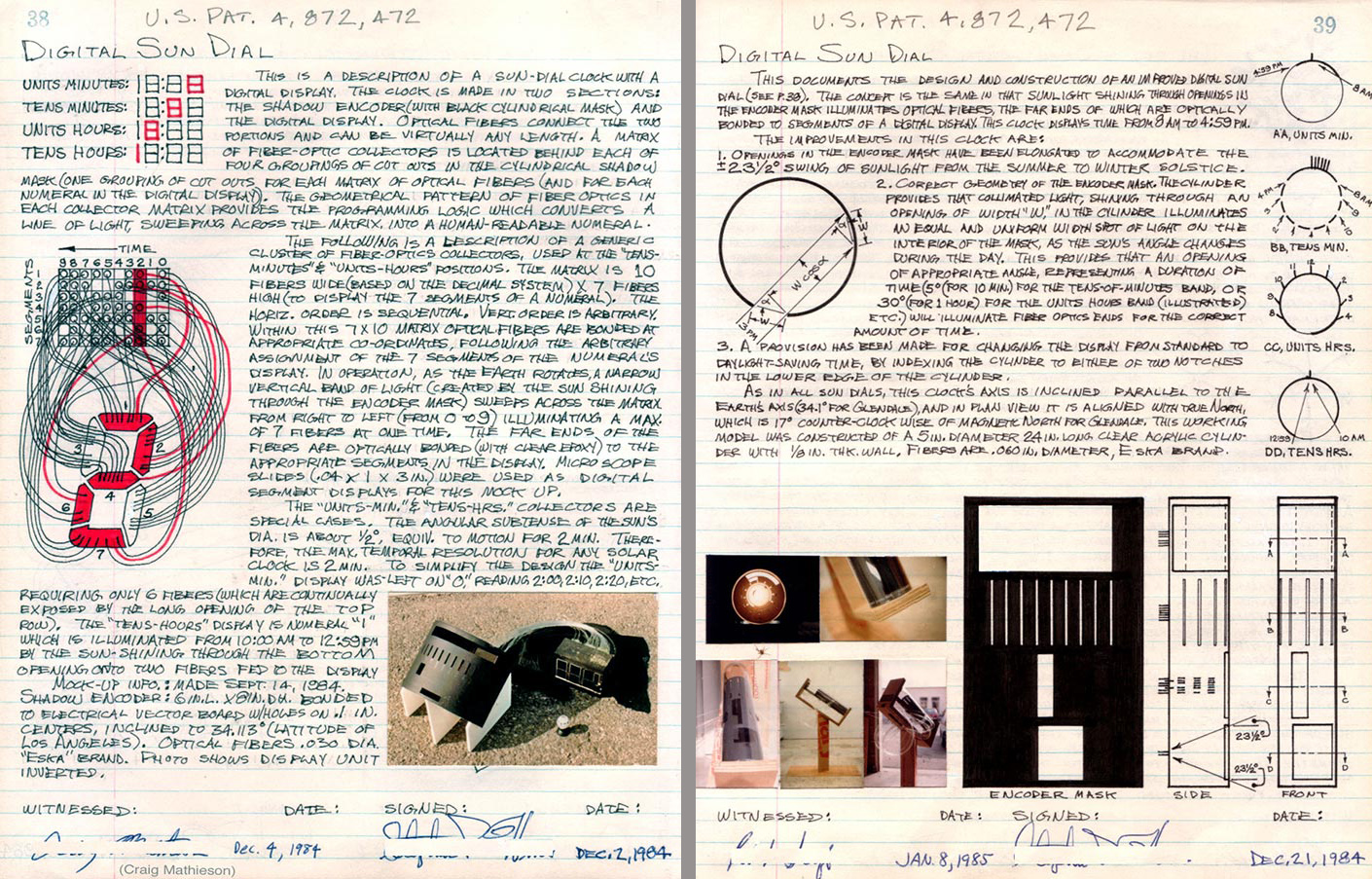
- Details
- Hits: 20215
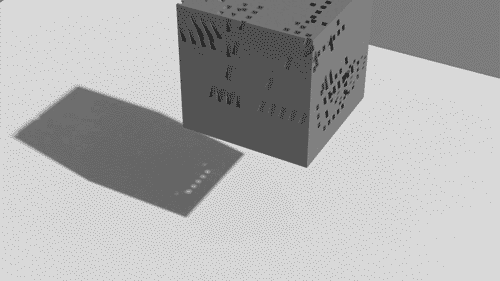
Voshart's Digital Cube
|
Chindōgu is the Japanese art of inventing ingenious things that are, well, Rube Goldberg. Daniel Voshart from Toronto has designed a solar time-telling cube from 59 stacked millboard plates. [See: Voshart Cube ] The result is a digital sundial, though not as universal as those patented Hines [USP 4,782.472], Scharstein [USP 5,590,093] or Kellogg [USP 05,596,553] but still, it is an interesting dial.

